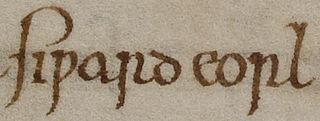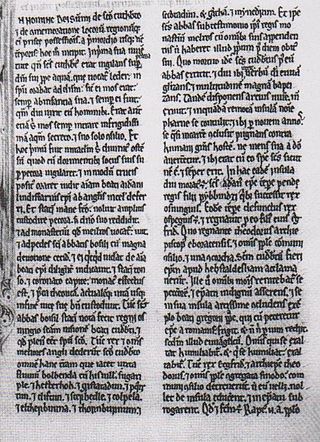Related Research Articles
Symeonof Durham was an English chronicler and a monk of Durham Priory.

Siward or Sigurd was an important earl of 11th-century northern England. The Old Norse nickname Digri and its Latin translation Grossus are given to him by near-contemporary texts. It is possible Siward may have been of Scandinavian or Anglo-Scandinavian origin, perhaps a relative of Earl Ulf, although this is speculative. He emerged as a regional strongman in England during the reign of Cnut. Cnut was a Scandinavian ruler who conquered most of England in the 1010s, and Siward was one of many Scandinavians who came to England in the aftermath, rising to become sub-ruler of most of northern England. From 1033 at the latest, he was in control of southern Northumbria, present-day Yorkshire, governing as earl on Cnut's behalf.

The Parker Library is a library within Corpus Christi College, Cambridge which contains rare books and manuscripts. It is known throughout the world due to its invaluable collection of over 600 manuscripts, particularly medieval texts, the majority of which were bequeathed to the college by Archbishop of Canterbury Matthew Parker, a former Master of Corpus Christi College.

The Anglian collection is a collection of Anglo-Saxon royal genealogies and regnal lists. These survive in four manuscripts; two of which now reside in the British Library. The remaining two belong to the libraries of Corpus Christi College, Cambridge and Rochester Cathedral, the latter now deposited with the Medway Archives.

The Libellus de exordio atque procursu istius, hoc est Dunhelmensis, ecclesie, in short Libellus de exordio, is a historical work of marked literary character composed and compiled in the early 12th-century and traditionally attributed to Symeon of Durham. It relates the history of bishopric and church of Durham and its predecessors at Lindisfarne and Chester-le-Street (Cunecacestre). It is sometimes also known as the Historia Dunelmensis ecclesiae.

De primo Saxonum adventu is a historical work, probably written in Durham during the episcopate of Ranulf Flambard (1099–1128). It recounts the coming of the English to Great Britain, treating individually the history of the rulers of the Kingdom of Kent, the Kingdom of East Anglia, the Kingdom of Northumbria, as well as the archbishops of Canterbury and the archbishops of York, the bishops of Durham and the earls of Northumbria.
The Historia Regum is a historical compilation attributed to Symeon of Durham, which presents material going from the death of Bede until 1129. It survives only in one manuscript compiled in Yorkshire in the mid-to-late 12th century, though the material is earlier. It is an often-used source for medieval English and Northumbrian history. The first five sections are now attributed to Byrhtferth of Ramsey.
De obsessione Dunelmi is an historical work written in the north of England during the Anglo-Norman period, almost certainly at Durham, and probably in either the late 11th or early 12th century.
David W. Rollason is an English historian and medievalist. He is a Professor in history at Durham University. He specialises in the cult of saints in Anglo-Saxon England, the history of Northumbria and in the historical writings of Durham, most notably producing a modern edition and translation of the Libellus de exordio and co-operating on an edition of the Durham Liber Vitae.
Cambridge, Corpus Christi College, MS 139 is a northern English manuscript compiled in c. 1170. Apart from preliminary additions, it contains two separate volumes, comprising 180 folios in total. The original first volume has 165 folios in twenty gatherings, about half of which are occupied by the historical compilation Historia regum, which runs from f. 51v to 129v. In the sixteenth century, the codex was bequeathed by Matthew Parker to the Parker Library of Corpus Christi College, Cambridge, where it is held to this day.
Northman was a late 10th-century English earl, with a territorial base in Northumbria north of the River Tees. A figure with this name appears in two different strands of source material. These are, namely, a textual tradition from Durham witnessed by Historia de Sancto Cuthberto and by the Durham Liber Vitae; and the other an appearance in a witness list of a charter of King Æthelred II dated to 994. The latter is Northman's only appearance south of the Humber, and occurred the year after Northumbria was attacked by Vikings.
Handbook for a Confessor is a compilation of Old English and Latin penitential texts associated with – and possibly authored or adapted by – Wulfstan (II), Archbishop of York. The handbook was intended for the use of parish priests in hearing confession and determining penances. Its transmission in the manuscripts seems to bear witness to Wulfstan's profound concern with these sacraments and their regulation, an impression which is similarly borne out by his Canons of Edgar, a guide of ecclesiastical law also targeted at priests. The handbook is a derivative work, based largely on earlier vernacular representatives of the penitential genre such as the Scrifboc and the Old English Penitential. Nevertheless, a unique quality seems to lie in the more or less systematic way it seeks to integrate various points of concern, including the proper formulae for confession and instructions on the administration of confession, the prescription of penances and their commutation.
Eadred Lulisc or Eadred of Carlisle is the abbot of Carlisle recorded by the Historia de Sancto Cuthberto. The Historia gives the abbot central place in the election of Guthred as king of Northumbria by the Viking army based in Yorkshire, and that subsequently Eadred purchased land from him, using it to endow the bishopric of St Cuthbert. The Historia also related that he and Eardwulf, Bishop of Lindisfarne, moved the body of St Cuthbert away from its previous base at Lindisfarne, tried to take it to Ireland, but failed and took it back to the east, first to Crayke and then to Chester-le-Street.
Thurbrand, nicknamed "the Hold", was a Northumbrian magnate in the early 11th century. Perhaps based in Holderness and East Yorkshire, Thurbrand was recorded as the killer of Uhtred the Bold, Earl of Northumbria. The killing appears to have been part of the war between Sweyn Forkbeard and Cnut the Great against the English king Æthelred the Unready, Uhtred being the latter's chief Northumbrian supporter. Thurbrand may also have attested a charter of 1009 and given a horse to Æthelred's son Æthelstan Ætheling. The killing is the first-known act, if it did not initiate, a bloodfeud between Thurbrand's family and Uhtred going into the time of Earl Waltheof. It is possible that Holderness took its name because of Thurbrand's presence or ownership of the peninsula.
Billfrith is an obscure Northumbrian saint credited with providing the jewel and metalwork encrusting the former treasure binding of the Lindisfarne Gospels. His name is thought to mean "peace of the two-edge sword".

The Historia de Sancto Cuthberto is a historical compilation finished some time after 1031. It is an account of the history of the bishopric of St Cuthbert—based successively at Lindisfarne, Norham, Chester-le-Street and finally Durham—from the life of St Cuthbert himself onwards. The latest event documented is a grant by King Cnut, c. 1031. The work is a cartulary chronicle recording grants and losses of property as well as miracles of retribution, under a loose narrative of temporal progression. The text survives in three manuscripts, the earliest of which dates from around 1100. The original version of the text is not thought to be extant; rather, all surviving manuscripts are thought to be copies of an earlier but lost exemplar. The Historia is one of the sources for the histories produced at Durham in the early 12th century, particularly the Historia Regum and Symeon of Durham's Libellus de Exordio.
On the Resting-Places of the Saints is a heading given to two early medieval pieces of writing, also known as Þá hálgan and the Secgan, which exist in various manuscript forms in both Old English and Latin, the earliest surviving manuscripts of which date to the mid-11th century. Secgan is so named from its Old English incipit, Secgan be þam Godes sanctum þe on Engla lande aerost reston "Tale of God's saints who first rested in England"), and is a list of fifty places which had shrines and remains of Anglo-Saxon saints. Þá hálgan is a version of the so-called Kentish Royal Legend is a heading which appears to be for both texts, as the Kentish legend, which comes first, is actually an account of how various members of the royal family of Kent, descendants of Æthelberht of Kent, founded monasteries and came to be regarded as saints. As such it is closer to other hagiographical texts than to the list of burial sites that follows it. The texts describe people living from the 7th to 10th centuries, and they exist in both Old English and Latin versions, but both have their earliest known manuscripts dating from the 11th century.
Durham, also known as De situ Dunelmi, Carmen de situ Dunelmi or De situ Dunelmi et de sanctorum reliquiis quae ibidem continentur carmen compositum, is an anonymous late Old English short poem about the English city of Durham and its relics, which might commemorate the translation of Cuthbert's relics to Durham Cathedral in 1104. Known from the late 12th-century manuscript, Cambridge, University Library, Ff. 1. 27, Durham has been described both as "the last extant poem written in traditional alliterative Old English metrical verse" and as being placed "so conveniently on the customary divide between Old and Middle English that the line can be drawn right down the middle of the poem." Scholars have dated the poem either to the twelfth century or to some point in the second half of the eleventh century.
The Chronicle of 957 is an anonymous Latin chronicle of Northumbria and the Kingdom of York covering the years 888–957. It is preserved in the manuscript Cambridge CCC 139 as a part of the 12th-century History of the Kings attributed to Symeon of Durham. There it functions as a continuation, after a long gap, of the Old Northumbrian Annals that cover the years 732–806 and some annals drawn from Asser's Life of Alfred for 849–887. The two Northumbrian chronicles are, however, entirely independent. The Chronicle of 957 is not contemporary with the events it describes, but was composed much later based on a now lost source. It ends with a note about the reign of Edward the Confessor (1042–1066).
References
- A Catalogue of the Manuscripts Preserved in the Library of the University of Cambridge, vol. 2, Cambridge: Cambridge University Press, 1857
- Rollason, David, ed. (2000), Libellus de Exordio atque Procursu istius, hoc est Dunhelmensis, Ecclesie = Tract on the Origins and Progress of this the Church of Durham / Symeon of Durham, Oxford Medieval Texts, Oxford: Clarendon Press, ISBN 0-19-820207-5
- South, Ted Johnson, ed. (2002), Historia de Sancto Cuthberto: A History of Saint Cuthbert and a Record of His Patrimony, Anglo-Saxon Texts No 3, Cambridge: D. S. Brewer, ISBN 0-85991-627-8